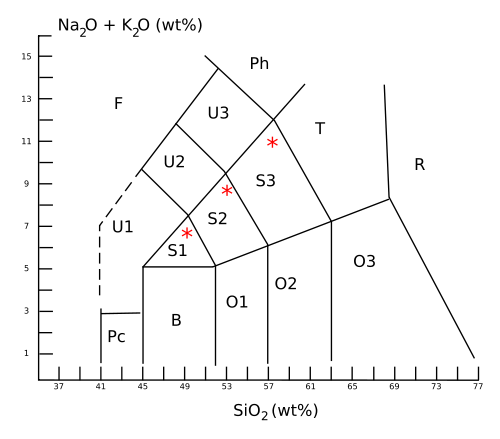
TAS classification
Encyclopedia
The TAS classification can be used to assign names to many common types of volcanic rock
s based upon the relationships between the combined alkali content and the silica content. These chemical parameters are useful, because the relative proportions of alkalis and silica play an important role in determining actual mineralogy and normative mineralogy
. The classification appears to be and can be simple to use for rocks that have been chemically analyzed. Except for the following quotation from Johannsen (1937), this entry is based upon Le Maitre and others (2002).
The subtitle of the classification chapter by Johannsen (1937) is "Chacun a son gout" (to each his own taste).
Furthermore, as discussed in considerable detail by Le Maitre and others (2002), the classification cannot be applied to all volcanic rocks. Certain rocks cannot be named using the diagram. For others, additional chemical, mineralogic, or textural
criteria must be used, as for lamprophyre
s.
The TAS classification should be applied only to rocks for which the mineral mode cannot be determined (otherwise, use a scheme based on mineralogy, such as the QAPF diagram
or one of the other diagrams presented in the entry for igneous rock
s). Before classifying rocks using the TAS diagram, the chemical analyses must be recalculated to 100% excluding water and carbon dioxide.
 The names provided by Le Maitre et al. (2002) for fields in the TAS diagram are listed below.
The names provided by Le Maitre et al. (2002) for fields in the TAS diagram are listed below.
B (Basalt
) (Use normative mineralogy
to subdivide)
O1 (Basaltic andesite
)
O2 (Andesite
)
O3 (Dacite
)
R (Rhyolite
)
T (Trachyte
or Trachydacite) (Use normative mineralogy to decide)
Ph (Phonolite
)
S1 (Trachybasalt
) *Sodic and potassic variants are Hawaiite
and Potassic Trachybasalt
S2 (Basaltic trachyandesite) *Sodic and potassic variants are Mugearite
and Shoshonite
S3 (Trachyandesite
*Sodic and potassic variants are Benmoreite
and Latite
Pc (Picrobasalt)
U1 (Basanite
or Tephrite
) (Use normative mineralogy to decide)
U2 (Phonotephrite)
U3 (Tephriphonolite)
F (Foidite) (Name according to dominant feldspathoid
when possible. Melilitites also plot in this area and can be distinguished by additional chemical criteria.)
Volcanic rock
Volcanic rock is a rock formed from magma erupted from a volcano. In other words, it is an igneous rock of volcanic origin...
s based upon the relationships between the combined alkali content and the silica content. These chemical parameters are useful, because the relative proportions of alkalis and silica play an important role in determining actual mineralogy and normative mineralogy
Normative mineralogy
Normative mineralogy is a geochemical calculation of the whole rock geochemistry of a rock sample that estimates the idealised mineralogy of a rock according to the principles of geochemistry....
. The classification appears to be and can be simple to use for rocks that have been chemically analyzed. Except for the following quotation from Johannsen (1937), this entry is based upon Le Maitre and others (2002).
Use of the TAS classification
Before using the TAS or any other classification, however, the following words of Johannsen (1937) should be kept in mind.- Many and peculiar are the classifications that have been proposed for igneous rocks. Their variability depends in part upon the purpose for which each was intended, and in part upon the difficulties arising from the characters of the rocks themselves. The trouble is not with the classifications but with nature which did not make things right. … Rocks must be classified in order to compare them with others, previously described, of similar composition and appearance. If this cannot be done on a genetic basis, then an artificial system must answer in order to serve as a card index to rock descriptions. Although this may be an evil thing, it is, at least, the least of several evils.
The subtitle of the classification chapter by Johannsen (1937) is "Chacun a son gout" (to each his own taste).
Furthermore, as discussed in considerable detail by Le Maitre and others (2002), the classification cannot be applied to all volcanic rocks. Certain rocks cannot be named using the diagram. For others, additional chemical, mineralogic, or textural
Rock microstructure
Rock microstructure includes the texture of a rock and the small scale rock structures. The words "texture" and "microstructure" are interchangeable, with the latter preferred in modern geological literature...
criteria must be used, as for lamprophyre
Lamprophyre
Lamprophyres are uncommon, small volume ultrapotassic igneous rocks primarily occurring as dikes, lopoliths, laccoliths, stocks and small intrusions...
s.
The TAS classification should be applied only to rocks for which the mineral mode cannot be determined (otherwise, use a scheme based on mineralogy, such as the QAPF diagram
QAPF diagram
A QAPF diagram is a double triangle diagram which is used to classify igneous rocks based on mineralogic composition. The acronym, QAPF, stands for "Quartz, Alkali feldspar, Plagioclase, Feldspathoid ". These are the mineral groups used for classification in QAPF diagram...
or one of the other diagrams presented in the entry for igneous rock
Igneous rock
Igneous rock is one of the three main rock types, the others being sedimentary and metamorphic rock. Igneous rock is formed through the cooling and solidification of magma or lava...
s). Before classifying rocks using the TAS diagram, the chemical analyses must be recalculated to 100% excluding water and carbon dioxide.
The TAS diagram

B (Basalt
Basalt
Basalt is a common extrusive volcanic rock. It is usually grey to black and fine-grained due to rapid cooling of lava at the surface of a planet. It may be porphyritic containing larger crystals in a fine matrix, or vesicular, or frothy scoria. Unweathered basalt is black or grey...
) (Use normative mineralogy
Normative mineralogy
Normative mineralogy is a geochemical calculation of the whole rock geochemistry of a rock sample that estimates the idealised mineralogy of a rock according to the principles of geochemistry....
to subdivide)
O1 (Basaltic andesite
Basaltic andesite
Basaltic andesite is a black volcanic rock containing about 55% silica. Minerals in basaltic andesite include olivine, augite and plagioclase. Basaltic andesite can be found in volcanoes around the world, including in Central America and the Andes of South America. Basaltic andesite is common in...
)
O2 (Andesite
Andesite
Andesite is an extrusive igneous, volcanic rock, of intermediate composition, with aphanitic to porphyritic texture. In a general sense, it is the intermediate type between basalt and dacite. The mineral assemblage is typically dominated by plagioclase plus pyroxene and/or hornblende. Magnetite,...
)
O3 (Dacite
Dacite
Dacite is an igneous, volcanic rock. It has an aphanitic to porphyritic texture and is intermediate in composition between andesite and rhyolite. The relative proportions of feldspars and quartz in dacite, and in many other volcanic rocks, are illustrated in the QAPF diagram...
)
R (Rhyolite
Rhyolite
This page is about a volcanic rock. For the ghost town see Rhyolite, Nevada, and for the satellite system, see Rhyolite/Aquacade.Rhyolite is an igneous, volcanic rock, of felsic composition . It may have any texture from glassy to aphanitic to porphyritic...
)
T (Trachyte
Trachyte
Trachyte is an igneous volcanic rock with an aphanitic to porphyritic texture. The mineral assemblage consists of essential alkali feldspar; relatively minor plagioclase and quartz or a feldspathoid such as nepheline may also be present....
or Trachydacite) (Use normative mineralogy to decide)
Ph (Phonolite
Phonolite
Phonolite is a rare igneous, volcanic rock of intermediate composition, with aphanitic to porphyritic texture....
)
S1 (Trachybasalt
Trachybasalt
Trachybasalt is a volcanic rock with a composition between trachyte and basalt. Minerals included in trachybasalt include alkali feldspar, calcic plagioclase, olivine, clinopyroxene and likely very small amounts of leucite or analcime. It contains high alkali content ....
) *Sodic and potassic variants are Hawaiite
Hawaiite
Hawaiite is an olivine basalt with intermediate composition between alkali olivine and mugearite. It was first described at the island of Hawaii. In gemology, hawaiite is a colloquial term for Hawaii-originated peridot,which is gem-quality olivine mineral....
and Potassic Trachybasalt
S2 (Basaltic trachyandesite) *Sodic and potassic variants are Mugearite
Mugearite
Mugearite is a type of orthoclase-bearing basalt, comprising olivine, apatite, and opaque oxides. The main feldspar in mugearite is oligoclase....
and Shoshonite
Shoshonite
Shoshonite is a basaltic rock, properly a potassic trachyandesite, composed of olivine, augite and plagioclase phenocrysts in a groundmass with calcic plagioclase and sanidine and some dark-colored volcanic glass. Shoshonite gives its name to the shoshonite series and grades into absarokite with...
S3 (Trachyandesite
Trachyandesite
Trachyandesite is an extrusive igneous rock. It has little or no free quartz, but is dominated by alkali feldspar and sodic plagioclase along with one or more of the following mafic minerals: amphibole, biotite or pyroxene...
*Sodic and potassic variants are Benmoreite
Benmoreite
Benmoreite is a silica undersaturated volcanic rock of intermediate composition. It is a variant of trachyandesite and belongs to the alkalic suite of igneous rocks. An origin by fractionation from basanite through nepheline hawaiite to nepheline benmoreite has been demonstrated for a volcanic...
and Latite
Latite
Latite is an igneous, volcanic rock, with aphanitic-aphyric to aphyric-porphyritic texture. Its mineral assemblage is usually alkali feldspar and plagioclase in approximately equal amounts. Quartz is less than five percent and is absent in a feldspathoid-bearing latite, and olivine is absent in a...
Pc (Picrobasalt)
U1 (Basanite
Basanite
Basanite is an igneous, volcanic rock with aphanitic to porphyritic texture.The mineral assembly is usually abundant feldspathoids , plagioclase, and augite, together with olivine and lesser iron-titanium oxides such as ilmenite and magnetite-ulvospinel; minor alkali feldspar may be present, as...
or Tephrite
Tephrite
Tephrite is an igneous, volcanic rock, with aphanitic to porphyritic texture. Mineral assembly is usually abundant feldspathoids , plagioclase, and lesser alkali feldspar. Pyroxenes are common accessory minerals. Quartz and olivine are absent. Occurrences include phonolite-tephrite Mt...
) (Use normative mineralogy to decide)
U2 (Phonotephrite)
U3 (Tephriphonolite)
F (Foidite) (Name according to dominant feldspathoid
Feldspathoid
The feldspathoids are a group of tectosilicate minerals which resemble feldspars but have a different structure and much lower silica content. They occur in rare and unusual types of igneous rocks....
when possible. Melilitites also plot in this area and can be distinguished by additional chemical criteria.)
- Sodic as used above means that Na2O - 2 is greater than K2O, and potassic that Na2O - 2 is less than K2O. Yet other names have been applied to rocks particularly rich in either sodium or potassium (as are ultrapotassic igneous rocks).

